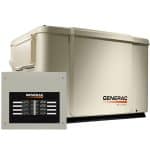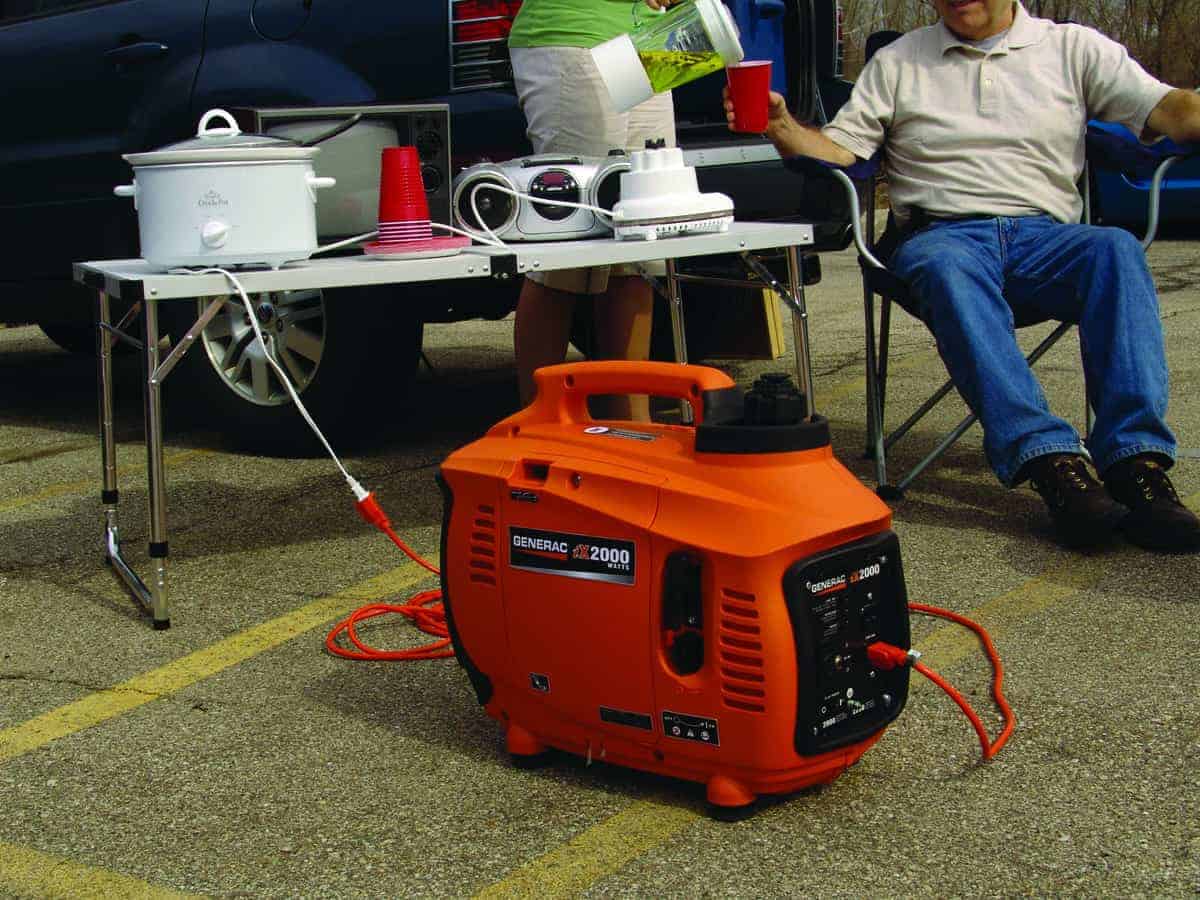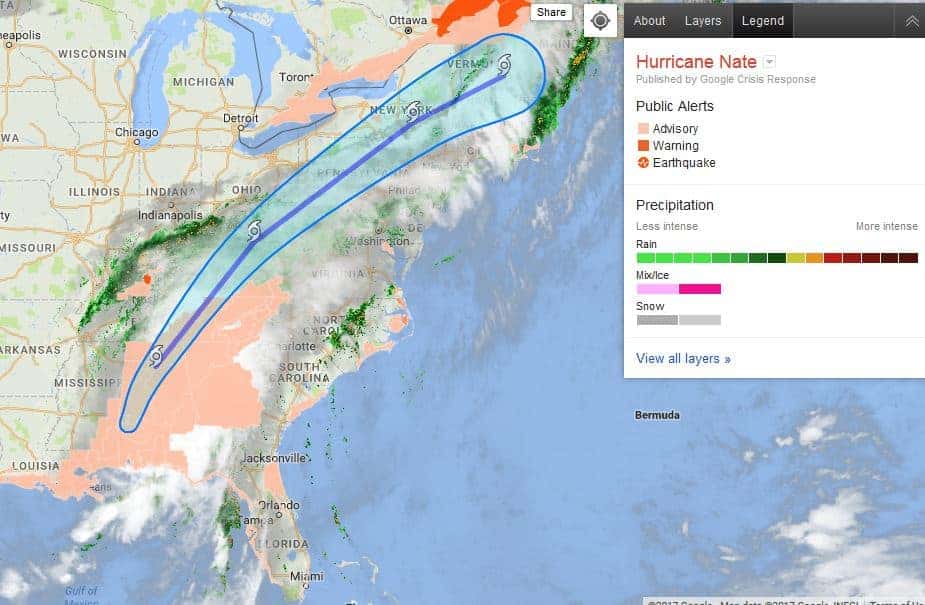Choosing a Home Generator for Backup Power Requires More than Cost Comparison.
A portable generator to home standby generator comparison is almost like comparing a moped to a motorcycle. The scooter will get you through town, but it’s not made for a road trip on the highway.
Portables generators are great because you can take them anywhere, but anything large enough to power your home for more than a few hours needs a lot of fuel, makes too much noise, and still requires an electrician if you want to run central air and heating.
Would you buy the moped or scooter for a cross country trip? Probably not.
Need to Know: Understanding Backup Generators
How Does a Portable Generator Work?
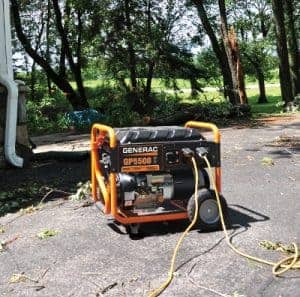
A 5500 Watt Portable Generator Supplies a Few Appliances with Power in the Aftermath of a Storm.
Portable generators are independent units. They use an engine to turn a generator and produce electrical power. Outlets allow connection to tools and appliances with extension cords or generator power cords. To supply a home with power including heating and air conditioning, they connect to a manual transfer switch and power previously selected circuits. It takes several steps to use them for backup power.
- Roll the generator out of the garage.
- Fill it with gasoline.
- Run extension cords indoors, or a generator cord to an inlet box.
- Start the generator.
- Add appliances to the cords or turn the transfer switch to generator power.
- Refuel several times a day—Disconnect appliances, turn it off, cool, refuel. Restart and reconnect.
You won’t do any of this during a severe storm and if it’s raining, you must have some way to shield it from the weather because you never run a generator indoors. Maintenance every 100 to 200 hours includes an oil change, oil and air filter change, and new spark plugs. You can take it to your local small engine repair shop or do it yourself.
Extension cords pose several hazards, including an increased risk of carbon monoxide poisoning. And, extension cords won’t supply power to a furnace or any other hard-wired appliance or overhead light. A manual transfer switch for portable generator powers any circuit selected during installation, eliminates extension cords, simplifies use, and makes a safe connection to the home electrical system.
How Does a Standby Generator Work?
A home standby generator has similar components to a portable generator, but the design allows it to work automatically. A microprocessor-based controller works in conjunction with an automatic transfer switch that can supply the entire home or some essential circuits. Because they permanently connect to the home’s existing electrical system and service panels, no one runs extension cords to connect appliances. They run on the existing natural gas supply or propane tank so refueling steps don’t become an issue.
When the power goes out, they turn on and automatically supply the home with power whether you’re on vacation, at work, or in bed sleeping. Except for scheduling maintenance—which the generator could do for you—a home standby generator doesn’t require much attention at all. You can also do it yourself if that is what you prefer.
How it Works—The Components of a Standby Generator
Fuel Requirements

Photographer Jim Occi captured these photos of gas lines following Hurricane Sandy.
Portable Generators usually run on gasoline. There are diesel models available and a few will run for several hours on a small propane tank like the one for your gas grill. A 6500 watt portable generator needs about 18 gallons of fuel per day—if you’re running it at half the rated load capacity. That’s a little less power than two standard 15-amp outlets in your home. Most municipalities limit gasoline storage to 25 gallons or less.
Looking for someplace to buy gasoline during an outage could leave you standing in line for hours—if you can find a gas station with electrical power. Refueling means shutting down and cooling before filling the tank. And those fuel supplies won’t last forever. Even with a stabilizer added they only last so long before you should rotate them into your vehicle.
Standby Generators operate on Natural Gas or Propane. They connect directly to your home’s existing natural gas service or propane storage tank. On natural gas, they can run for days or weeks if necessary. Refueling a propane tank is as simple as calling your LP Gas company.
Noise of Portable or Standby Generators
Some generators are very quiet. Others produce enough noise to rattle your teeth. There is no industry standard for measuring portable generator sound levels while most manufacturers brag about the quiet operation of their home standby generators.
Portable inverters rank among the quietest among portables with decibel ratings from 50dB to 70dB. Regular portables start around 68dB and go as high as 85dB. For comparison purposes, most home central air conditioning units operate between 65dB to 70dB.
An air-cooled home standby generator falls into the same range as the central A/C unit with most measuring 67dB to 68dB. Some liquid-cooled generators are exceptionally quiet. You can hear the birds chirping while standing within a few feet of them.
Generator Noise Levels: How Loud are They?
How to Select a Generator for Your Home
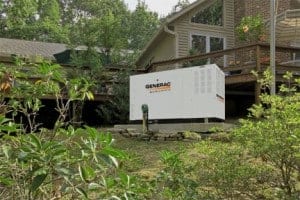
A standby generator keeps families and homes safe with backup power for heating and cooling, refrigeration, pumps, and other critical home systems
The process of choosing a generator starts with knowing just how much power a home requires. Quite often, different homeowners with similar sized homes choose very different generators. A Sizing Guide can help and Norwall has different guides for different types of generators.
A Power Calculator helps make choices by adding up the power of various appliances. Checking boxes adds the power required for each appliance to the total. Check everything in a house and it displays the power required to run everything. Choose only the important essentials and that is what it will show you.
Using the power calculator and the sizing guide help make important choices and fit them into your budget. A generator installed with an automatic transfer switch that offers power management can do the work of a larger generator more efficiently although you may wait for some loads to run.
For most homeowners, a home standby generator makes the most sense. No fuel to store and rotate. Weather is not a concern. Automatic operation ensures the sump pump runs when it must and the refrigerator stays cold. No one has to hook up the portable and get it started or keep it fueled during inclement weather.
Updated August 3, 2018
Standby Generator Buyer Guide: What Size Generator Do I Need?



